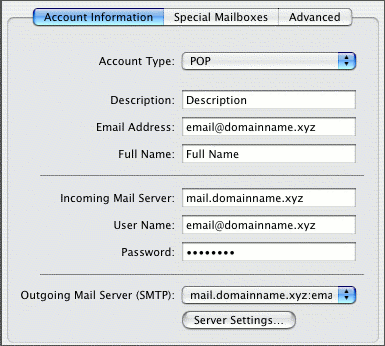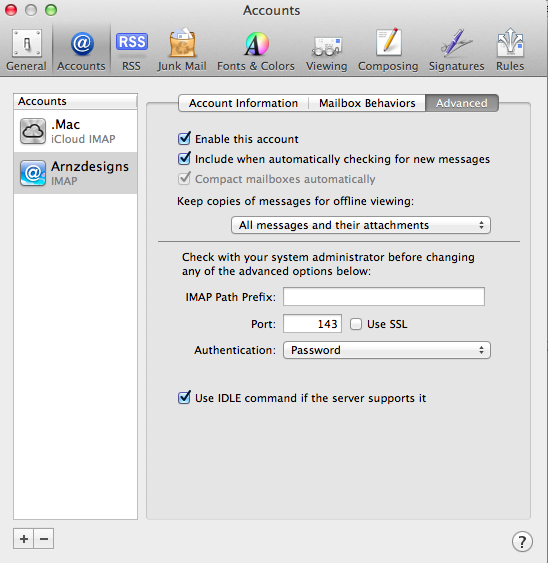Mac Settings For Mail
Need to verify your email settings? Simply enter your email address below and we will use it to provide your Mail settings.
- Mac Mail Settings For Hotmail
- Mac Mail Settings For Gmail
- Mac Mail Settings For Hotmail
- Mac Mail Settings For Yahoo Email

- Set up Apple Mail (OS X) for AT&T email Use these steps to set up your email for the first time or on a new computer. From Mail, select Mail Preferences. Choose Accounts and then select the + (plus sign).
- Apple Mail is the default email client that comes with every Mac using OS X 10.0 or later. On occasion, you may find the need to update the settings in this program (ie: new password, connection issues, etc).This guide will provide information on how to update the Apple Mail settings.
- Change Server Settings in Mail on Mac Use Server Settings preferences in Mail to change options for an account’s incoming and outgoing (SMTP) mail servers. To change these preferences in the Mail app on your Mac, choose Mail Preferences, click Accounts, then click Server Settings. Note: The settings you see vary depending on your account type.
Depending on your email provider, this is usually either your full email address or the part of your email address before the '@' symbol. This is the password you'll use to access your account. The password is usually case-sensitive. Incoming server. The incoming mail server for an IMAP account may also be called the IMAP server. POP3 and IMAP email settings Your desktop email program (like Microsoft Outlook or Apple Mail) or mobile email app will use either POP3 or IMAP to send and receive email. Be sure to use the right server and port settings.
Incoming Mail Server
Authentication
Mac Mail Settings For Hotmail
Password
MD5 Challenge-Response
Kerberos Version 5 (GSSAPI)
Authenticated POP (APOP)
NTLM
None
Outgoing Mail Server
Outgoing Mail Server (Mac OS)
Authentication
Password
MD5 Challenge-Response
Kerberos Version 5 (GSSAPI)
Authenticated POP (APOP)
NTLM
None
Incoming Mail Server
Authentication
Password
MD5 Challenge-Response
Kerberos Version 5 (GSSAPI)
Authenticated POP (APOP)
NTLM
None
Outgoing Mail Server (iOS)
Authentication
Password
MD5 Challenge-Response
Kerberos Version 5 (GSSAPI)
Authenticated POP (APOP)
NTLM
None


Note: Apple may collect and use your domain address (i.e. yahoo.com, gmail.com, etc.) for purposes of improving our products and services. Otherwise, your full email address will not be stored and will not be used by Apple or shared with any other entities.
If you can’t send email on your iPhone, iPad, or iPod touch
If you can’t send email from the Mail app on your iPhone, iPad, or iPod touch, there are a few things you can try.
Get help with iOS mailIf you can’t send email on your Mac
Check for status messages that tell you more about the issue and how to fix it.
Get help with mailTell us how we can help
Answer a few questions and we'll help you find a solution.
Get supportThis guide shows you step-by-step how to set up email account in Mail on MacOS.
Add New Account
- Choose Preferences, from the Mail menu.
- Select Preferences.
- Click on the Accounts icon in the Mail Preferences window.
- On the Accounts window, click the + (plus) sign to create a new account.
Account Settings
- Choose Other Mail Account...
- Enter your Full Name, or your name as you would like it to appear on your sent email.
* Replace example.com with your own domain name. - Enter your Email Address.
- Enter your email account's password.
- Click the Next button.
- A message should appear saying 'Account must be manually configured'. Click Next.
Incoming and Outgoing Mail Server Settings
When entering the information for your Incoming Mail Server you will need to decide if you would like to use POP3 or IMAP. POP3 will download and remove all of the emails from our server, whereas IMAP will synchronize the emails between your email client(s) and our server. IMAP is recommended if you will be using this email account with multiple devices since they will all synchronize.
Not sure if you want POP or IMAP? Read more about it on Webmail and Email Applications: IMAP and POP
- * Replace example.com with your own domain name.
- Choose your account type, either IMAP or POP.
- Enter mail.example.com as the Incoming mail server, replacing example.com with your own domain name.
- Enter your full email address as the User Name.
- Enter the Password of your email account.
- Configure the Incoming and Outgoing Server. For more information, refer to Email Client Settings.
- Once Incoming Server settings have been configured, you will need to enter the Outgoing Mail Server (SMTP) setting. Enter one of the following options:
- Click the Server Settings button. You will be prompted to further configure your Outgoing Mail Server.
- Enter the Outgoing Mail Server again.
- Choose your Server port:
- Choose Password for Authentication.
- Re-enter the full email address as the User Name, and the password for that email account.
- Click the OK button when finished.
Mac Mail Settings For Gmail
Note: If you choose to use an SSL, you may see an SSL warning. Please see SSL Certificate Warning for the next steps.
SSL Certificate Warning
If you choose to use SSL, you may receive a message warning you that the certificate is not trusted. If you receive this message, follow these steps:
- Click the Show Certificate button.
- Check the box to Always trust the certificate.
- Click the Connect button.
Complete Set Up on Yosemite OS
Mac Mail Settings For Hotmail
If you're running Yosemite, we suggest following these steps to make sure your account settings don't change. This only applies to Apple computers running Yosemite.
Mac Mail Settings For Yahoo Email
- Choose Preferences, from the Mail menu.
- Click on the Accounts tab.
- Next, click on the Advanced.
- Uncheck the option labeled 'Automatically detect and maintain settings
- Now click on the Account Information tab.
- Under Outgoing Mail Server (SMTP), select Edit SMTP Server List.
- Click the Advanced tab.
- Uncheck the option labeled Automatically detect and maintain settings.
- Click the OK button when finished.
